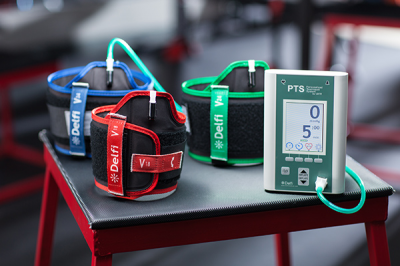Suffering an injury can be a difficult time for an athlete. The athlete may experience forms of depression from an inability to participate in practices, training sessions, and competition. As a physical therapist and strength coach, it is essential that we find methods to keep the athlete prepared for a return to competition, physically and mentally. One method to keep an athlete physically prepared for a return to performance is the application of blood flow restriction (BFR) training.

What is Blood Flow Restriction Training?
Blood Flow Restriction training entails applying an FDA approved medical grade tourniquet to an extremity and restricting 50-80% arterial blood flow into the limb and 100% venous blood flow from the limb.
What is the benefit of BFR?
The American College of Sports Medicine (ACSM) suggests that strategies to increase muscle strength and muscle hypertrophy, the size of the muscle, consist of performing 8 - 12 repetitions at intensities of 60-85% of an individual’s one rep max (1rm). For example, if an individual’s 1rm in the squat is 100 pounds, the ACSM recommends that to see an increase in strength and/or hypertrophy, that individual should perform squatting activities utilizing anywhere from 60-85 pounds.
By utilizing BFR, we can elicit these same strength and hypertrophy increases utilizing only 20-30% of an individual’s 1rm. Using the same example individual from above. Rather than having to utilize 60-85 pounds to elicit increases in muscular strength and hypertrophy, with the use of BFR we can now apply a load of 20-30 pounds to achieve the desired adaptation. This results in a much less load applied to the entire system and specific joint, while achieving the same desired benefit. This makes the application of BFR an excellent option for the athlete or individual recovering from an injury or while performing training sessions during the competitive season.
How does BFR achieve these results?
The exact mechanisms behind why BFR has shown such positive benefits is still unknown but current research projects have provided a number of theories. Current literature suggests that these benefits are likely a combination of anaerobic metabolism producing a significant build-up of metabolites, a systemic anabolic response, and cellular swelling. In addition to this combination of mechanisms, BFR has consistently demonstrated an ability to induce muscle protein synthesis which is likely another contributing factor.
To learn more about Blood Flow Restriction training or to find a list of certified providers in your area, visit http://www.owensrecoveryscience.com
Ready to get started with BFR today? Contact Impact Performance Therapy to set up an initial evaluation to begin your training process!